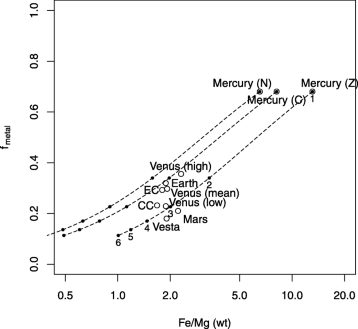当前位置:
X-MOL 学术
›
Prog. Earth Planet. Sci.
›
论文详情
Our official English website, www.x-mol.net, welcomes your
feedback! (Note: you will need to create a separate account there.)
The chemical case for Mercury mantle stripping
Progress in Earth and Planetary Science ( IF 3.5 ) Pub Date : 2019-12-11 , DOI: 10.1186/s40645-019-0312-z George Helffrich , Ramon Brasser , Anat Shahar
Progress in Earth and Planetary Science ( IF 3.5 ) Pub Date : 2019-12-11 , DOI: 10.1186/s40645-019-0312-z George Helffrich , Ramon Brasser , Anat Shahar
Mercury, the Solar System’s innermost planet, has an unusually massive core prompting speculation that the planet lost silicate after it formed. Using the unusually high sulfur and low iron composition of its surface and space geodetic constraints on its core composition, we show Mercury’s chemistry to be compatible with formation in a larger planet at minimum 1.4–2.5 times Mercury’s present mass and possibly 2–4 times its mass by similarity with other rocky Solar System bodies. To do this, we apply an experimentally determined metal-silicate partitioning model for sulfur to Mercury’s silicate. The model is validated by applying it to Vesta, which, when evaluated at the conditions of Vestan self-differentiation, yields sulfur contents in its silicate in the range of HED meteorites. Mercury could have lost a substantial fraction of its rocky material through impacts or by being itself a remnant impactor. Independent of any stripping, because a significant amount of silicon resides in Mercury’s core, silicate meteoritic debris from Mercury would likely be characterized by 30Si isotopic enrichment >+ 0.10‰ relative to parent sources that could aid identification of a new meteorite class.
中文翻译:

水银地幔剥离的化学情况
水星是太阳系的最里面的行星,其核心具有异常大的质量,这促使人们推测该行星在形成后会损失硅酸盐。利用其表面和空间大地测量对核组成的异常高的硫和低铁组成,我们证明了水星的化学性质与更大行星中的地层相容,其最小质量是水星的现有质量的1.4-2.5倍,可能是其质量的2-4倍。通过与其他岩石太阳系天体的相似性来质量。为此,我们将实验确定的硫的金属硅酸盐分配模型应用于水银的硅酸盐。该模型通过将其应用于Vesta进行验证,当在Vestan自扩散条件下进行评估时,该模型在其硅酸盐中产生的硫含量在HED陨石范围内。水星可能会因撞击或本身成为残余撞击物而损失掉大部分岩石材料。与任何剥离无关,因为大量的硅残留在水星的核心中,所以水星的硅酸盐陨石碎片可能具有以下特征:相对于母源,30 Si同位素富集> + 0.10‰,可帮助鉴定新的陨石类。
更新日期:2019-12-11

中文翻译:

水银地幔剥离的化学情况
水星是太阳系的最里面的行星,其核心具有异常大的质量,这促使人们推测该行星在形成后会损失硅酸盐。利用其表面和空间大地测量对核组成的异常高的硫和低铁组成,我们证明了水星的化学性质与更大行星中的地层相容,其最小质量是水星的现有质量的1.4-2.5倍,可能是其质量的2-4倍。通过与其他岩石太阳系天体的相似性来质量。为此,我们将实验确定的硫的金属硅酸盐分配模型应用于水银的硅酸盐。该模型通过将其应用于Vesta进行验证,当在Vestan自扩散条件下进行评估时,该模型在其硅酸盐中产生的硫含量在HED陨石范围内。水星可能会因撞击或本身成为残余撞击物而损失掉大部分岩石材料。与任何剥离无关,因为大量的硅残留在水星的核心中,所以水星的硅酸盐陨石碎片可能具有以下特征:相对于母源,30 Si同位素富集> + 0.10‰,可帮助鉴定新的陨石类。












































 京公网安备 11010802027423号
京公网安备 11010802027423号